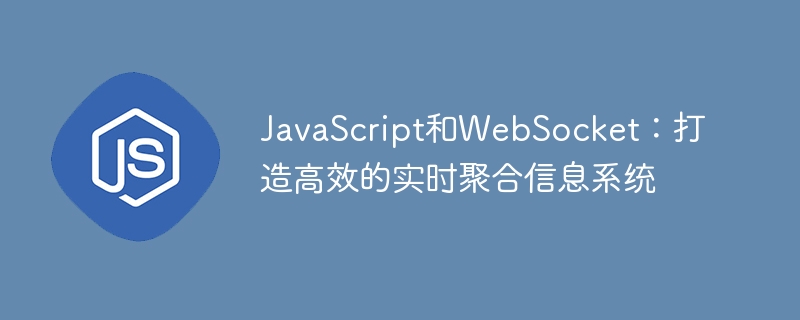Home >Web Front-end >JS Tutorial >JavaScript and WebSocket: Create an efficient real-time aggregated information system
JavaScript and WebSocket: Create an efficient real-time aggregated information system
- WBOYOriginal
- 2023-12-17 22:49:021176browse

JavaScript and WebSocket: Create an efficient real-time aggregation information system
Abstract: WebSocket is a two-way communication protocol based on the TCP protocol that can be used between the browser and the server. Establish a persistent connection between them to achieve real-time two-way communication. As modern web applications increasingly require real-time and interactivity, the combination of JavaScript and WebSocket can create an efficient real-time aggregation information system. This article will introduce the basic principles, advantages and application of WebSocket in JavaScript, and provide specific code examples.
Introduction:
In the early days of web applications, HTTP was widely used for communication between browsers and servers. However, HTTP is a stateless protocol, which requires the browser to establish a new connection every time it requests, which is not suitable for real-time two-way communication. To solve this problem, WebSocket came into being.
1. Basic principles and advantages of WebSocket
- Basic principle: WebSocket achieves real-time two-way communication by establishing a persistent connection between the browser and the server. It uses the standard HTTP protocol for handshake, and then upgrades the connection to a full-duplex WebSocket connection, achieving low-latency, high-efficiency two-way communication.
-
Advantages:
- Real-time: WebSocket can transmit data from the server to the browser in real time, achieving real-time update effects and allowing users to feel a faster response speed.
- Low latency: The connection established by WebSocket is durable, avoiding the time overhead of repeatedly establishing a connection and reducing latency.
- Two-way communication: WebSocket supports two-way communication between the server and the browser, enabling real-time data push and interaction.
- Cross-platform: WebSocket is based on the standard TCP protocol and can be used on various platforms and is not limited to a specific operating system or browser.
2. WebSocket application in JavaScript
JavaScript provides the WebSocket API to facilitate developers to use WebSocket in the browser for real-time communication. Here are some common scenarios and sample code for using WebSockets in JavaScript:
-
Connecting to the server
const socket = new WebSocket('ws://localhost:8080'); // 连接服务器 socket.onopen = function() { console.log('连接服务器成功'); }; socket.onclose = function() { console.log('与服务器连接断开'); }; socket.onerror = function() { console.log('连接错误'); }; socket.onmessage = function(event) { console.log('收到服务器消息:', event.data); }; -
Sending a message to the server
// 发送字符串 socket.send('Hello, Server!'); // 发送JSON对象 const data = { name: 'John', age: 25 }; socket.send(JSON.stringify(data)); -
Receive server message
socket.onmessage = function(event) { const data = JSON.parse(event.data); console.log('收到服务器消息:', data.message); }; -
Disconnect
socket.close();
3. Application scenarios of real-time aggregation information system
- Instant messaging system: Real-time messaging and user chat functions are realized through WebSocket.
- Real-time trading system: Update stock prices, commodity information, etc. in real time through WebSocket.
- Real-time collaboration system: Multiple users edit the same document at the same time, able to collaborate in real-time and see each other's operations in real-time.
- Multiplayer game system: Real-time sound, position synchronization and other functions of the game.
Conclusion:
The combination of JavaScript and WebSocket can create an efficient real-time aggregation information system. WebSocket provides real-time, low-latency, two-way communication capabilities and can meet the real-time and interactivity needs of modern Web applications. Through the WebSocket API in JavaScript, developers can easily implement real-time communication in the browser. Proper use of WebSocket can bring a better user experience to users and expand the functionality of applications.
The above is the detailed content of JavaScript and WebSocket: Create an efficient real-time aggregated information system. For more information, please follow other related articles on the PHP Chinese website!
Related articles
See more- Detailed explanation of websocket examples for WeChat applet development
- Detailed explanation of examples of implementing WebSocket server-side instant messaging using .NET
- Detailed explanation of the steps to implement websocket real-time message push in PHP
- What is the difference between jsp and javascript
- How to define enum (enumeration type) in JavaScript? how to use?

